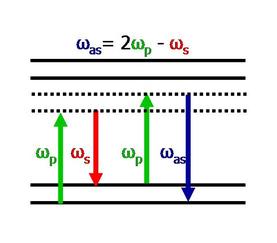
| Physics and Astronomy |
|
| Physics Home | Study here | Our Teaching | Our Research | Our Centres | News | Work here | EMPS |
|
Multiphoton Imaging and Spectroscopy
Biomedical Physics Group home page
|
|
Back to top
Coherent Anti-Stokes Raman Scattering (CARS)
CARS is a third order nonlinear optical process in which a pump field Ep and a Stokes field Es interact with a sample to generate a signal field Eas at the anti-Stokes frequency of ωas = 2ωp - ωs. When ωp - ωs is tuned to be resonant with a molecular vibration (&Omega), the CARS signal can be significantly enhanced, producing a vibrational contrast. Unlike spontaneous Raman scattering, CARS produces a highly directional field. The two excitation beams (ωp and ωs) form a beating field with frequency ωp - ωs. When ωp - ωs matches &Omega all the molecules within the interaction volume vibrate in-phase.
AdvantagesCARS microscopy permits biological imaging with several advantages:
|
